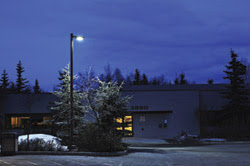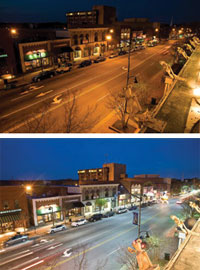Technology is the great catalyzer, catapulting the LED industry forward by enhancing existing applications and enabling new ones. Many technological advances are pushing LEDs away from the old single-color realm where they were used for specific applications such as emergency exit signs or brake lights, and closer to a domain where they play more versatile roles as replacements for the everyday white lightbulb, street lighting, surgical lighting and more.
Getting the light right
Producing LEDs that illuminate our homes and streets – or even our skin, as in surgical applications – would be impossible without advances in phosphors, materials and packaging. Natural white light is measured by the color rendering index (CRI), which is based on the light’s ability to produce the truest color of the object being illuminated. Skin, for example, looks best when illuminated by a light source with a CRI of 70 or more.

LEDs illuminate a parking lot at the University of Alaska in Anchorage. (AP Photo/Matt Hage)
Phosphors are chemicals that glow in various colors when excited and combine to form white light. Phosphor technology is one of the most active areas in chip development, according to Dr. Ralph Wirth, head of conceptual engineering for components at Osram Opto Semiconductors in Regensburg, Germany. Wirth sees phosphor combinations as “door openers that enable new applications.” Osram recently released several new chip designs, all of which use phosphor conversion. “The main applications all use white light,” Wirth noted. He said that Osram develops chips that allow customers to capitalize on the unique benefits of the LED. The main task with the new chips, he noted, was to improve the extraction efficiency and reflectivity to make the most of the light.
Sharp Corp. makes use of an advanced phosphor process with its new white-light LEDs with a CRI of 80, which is achieved through a combination of a blue LED die covered with a mixture of green and red phosphors. These LEDs are intended for applications including photography, store windows and decorations, where it’s important to see the true colors of products, and surgical lighting, where seeing the exact skin color is necessary.
Another approach to using LEDs in medicine is to squeeze the light through a fiber optic illuminator. PerkinElmer of Waltham, Mass., recently introduced a lighting solution that uses an optical light engine that squeezes high-intensity white light into 3- to 10-mm fiber optic bundles. By means of proprietary drivers and software, the light can be dimmed without losing its color temperature, pattern or uniformity, according to Joel Falcone, vice president and general manager of PerkinElmer’s global illumination business.
This fiber optic illuminator can be used in endoscopy, microscopy and machine vision. In endoscopy, for example, it replaces conventional light sources such as halogen and xenon, which Falcone noted have a limited lifetime and consume significantly more energy. LEDs, by comparison, have a lifetime 10 times that of conventional light sources. Falcone added that, “Eliminating the need to replace the source lamp every 12 months provides the hospitals and practitioners a significant cost savings opportunity, and it is environmentally friendly.”
Energy smarts
One of the greatest drivers for many industries right now is energy savings, and the big push in the lighting industry is to increase the output of lumens per watt. The US Department of Energy (DoE) has set a long-term research goal of 160 lumens per watt in “cost-effective, market-ready” LEDs by 2025. The industry is not far from that goal. In April, Cree Inc. of Durham, N.C., announced white LEDs with 139 and 132 lumens per watt at 350 mA.
Adding to the DoE push is a performance threshold for lightbulbs as mandated by the Energy Independence and Security Act (EISA) of 2007. New research is going into incandescents and compact fluorescents to try to meet or exceed the thresholds, but high-brightness, high-efficiency LEDs already have a leg up in terms of efficiency. Advances inside the LED die and package that reduce refraction losses, as well as advances in thermal management contribute to efficiency gains. Paul Scheidt, product marketing manager for Cree’s LED components group, noted that other optimizations – such as increased light output, reduced forward voltage and improved phosphor system efficiency – further increase performance and efficiency. He added, “We know how to create LEDs that purely optimize for efficiency, but the real question is this: Does that super-efficient LED produce light that people would actually use?”
According to Scheidt, other sources of light, such as low-pressure sodium, are also efficient, and they’re relatively inexpensive as well. But the problem, he said, is that the light is a “yucky yellow brown that makes it impossible to tell the differences in color under the lights.” Creating light that is pleasing will help drive LED adoption.

Before and after images show the effect of LED lighting fixtures that were installed in the downtown Chapel Hill, N.C., as part of Cree Inc.’s LED City initiative. Photos courtesy of Cree.
LEDs are used in grocery store refrigeration cases and other applications and seem to be passing the consumer eyeball test. In a survey conducted by Rensselaer Polytechnic Institute’s Lighting Research Center in Troy, N.Y., shoppers chose LED over fluorescent lighting because LED lighting is brighter, more even and makes food labels easier to read. Refrigerator and freezer applications are great uses for LEDs because they like the cold. Couple that with all the other benefits of LEDs, and not only are the shoppers happy, but the store owners also benefit from reduced overall costs. A report by General Electric, which produces LEDs for grocery store refrigeration units, estimates that if a retailer were to replace fluorescent lamps for 100 refrigerated case doors in each of its 100 stores, it could save more than a half-million dollars a year and reduce carbon emissions by more than 5.2 million lb – the equivalent of planting more than 650 acres of trees a year (based on 24/7 operation at 10 cents per kWh).
While lighting in the grocery store affects many people, the ultimate consumer use for LEDs is replacement lightbulbs. We still can’t buy them at our neighborhood hardware store, but LED bulbs are now popping onto the market. And although prices are high compared with other types of lighting, costs are expected to go down as production goes up. Lighting Science Group Corp. of Westampton, N.J., the company behind some of the most visible LED applications in the world, including the 2009 Times Square New Year’s Eve Ball and 7 World Trade Center, recently announced an LED lightbulb. Fred Maxik, the company’s director and chief technology officer, said that efficiency has at least doubled in the past 24 months, to the point where we’re approaching “a true replacement on a lumen-for-lumen basis.” The new lightbulb screws into a traditional socket and replaces a 60-W incandescent or 13-W fluorescent bulb. It uses 7.4 W and is expected to last six times longer than the average compact fluorescent. The bulb is expected to cost $25.
Setting the standard
Standards are important in the bulb replacement market. The consumer information that the LED lightbulb industry will provide on its packaging – and that consumers have become accustomed to reading when buying incandescent bulbs – will benefit the industry. About a year ago, the Illuminating Engineering Society of North America published the LM-79 standard for testing solid-state lighting products, giving the lighting industry benchmarks that have enabled lighting designers to concentrate on innovations such as LED lightbulbs, optical control and more.
The standard gives photometric information on lumen output and intensity, chromaticity coordinates, correlated color temperature and the color rendering index for solid-state lighting products. Electrical information includes current, voltage and power. What the standard means, according to Scheidt, is that LED luminaires are all measured consistently. He equated the standard to the US Environmental Protection Agency gas mileage for cars. “Without that standard, car makers could each decide how to measure mileage, and you probably couldn’t compare the numbers from one maker to the numbers from another. LM-79 serves a very similar purpose for the LED lighting industry.”
By using LEDs to light up a parking garage at Tufts University in Boston, Lighting Science Group estimates an energy savings of 56 percent over what was consumed by the metal halide fixtures previously used. In addition to savings on the electric bill, there are the longevity and maintenance factors. With advances in thermal designs, LEDs are expected to last 50,000 hours, which is 50 times the life of a typical incandescent bulb and five times the average for a compact fluorescent. Bulbs that last 50 times as long as other lighting sources are changed 50 times less often, thus dramatically reducing maintenance costs. In the Tufts garage, for example, savings on energy and maintenance is expected to be more than $27,000 with a three-year payback.
Signage and street lights are additional applications where reductions in maintenance costs are driving increased use of LEDs.
No stopping now
The science of solid-state lighting is still relatively new and rapidly advancing. Yet we’ve crossed a threshold, according to Nadarajah Narendran, director of research at the Lighting Research Center, “where performance is comparable [to] or better than traditional lighting.” Companies are taking different approaches to creating solutions to meet the requirements for specific lighting applications and, as Narendran pointed out, quality can vary. But as quality goes up and price comes down, LEDs will become predominant in street lighting, parking garages, store lighting, freezer cases, building interiors and exteriors, and more.
LED technology also has capabilities that will extend beyond general illumination. The tunability of LEDs is one area of research that may have an impact on how light affects biology. As Lighting Science Group’s Maxik explained, by enhancing or removing certain areas in the spectral waveform, we may be able to change the pattern of disease or to enhance vision. The science of light is also advancing from a materials angle, giving designers more control over the shape, quality and intensity of light coming out of the fixture, which can reduce or eliminate light pollution. The bottom line is that LEDs are no longer the lighting technology of tomorrow – they are here today in use in myriad general illumination applications.